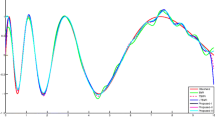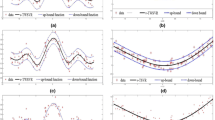Abstract
In this paper, motivated by the works on twin parametric insensitive support vector regression (TPISVR) (Peng in Neurocomputing 79(1):26–38, 2012), and Lagrangian twin support vector regression (Balasundaram and Tanveer in Neural Comput Appl 22(1):257–267, 2013), a new efficient approach is proposed as Lagrangian twin parametric insensitive support vector regression (LTPISVR). In order to make the objective function strongly convex, we consider square of 2-norm of slack variables in the optimization problem. To reduce the computation cost, the solution of proposed LTPISVR is obtained by solving simple linearly convergent iterative schemes, instead of quadratic programming problems as in TPISVR. There is no requirement of any optimization toolbox for proposed LTPISVR. To demonstrate the effectiveness of proposed method, we present numerical results on well-known synthetic and real-world datasets. The results clearly show similar or better generalization performance of proposed method with lesser training time in comparison with support vector regression, twin support vector regression and twin parametric insensitive support vector regression.












Similar content being viewed by others
References
Balasundaram S, Tanveer M (2013) On Lagrangian twin support vector regression. Neural Comput Appl 22(1):257–267
Bao Y-K, Liu Z-T, Guo L, Wang W (2005) Forecasting stock composite index by fuzzy support vector machines regression. In: Proceeding of international conference on machine learning and cybernetics, vol 6, pp 3535–3540
Box GEP, Jenkins GM (1976) Time series analysis: forecasting and control. Holden-Day, San Francisco
Brockwell PJ, Davis RA (2002) Introduction to time series forecasting, 2nd edn. Springer, Berlin
Casdagli M (1989) Nonlinear prediction of chaotic time series. Physica 35D:335–356
Cortes C, Vapnik V (1995) Support-vector networks. Mach Learn 20(3):273–297
Cristianini N, Shawe-Taylor J (2000) An introduction to support vector machines and other kernel based learning methods. Cambridge University Press, Cambridge
DELVE (2005) Data for evaluating learning in valid experiments. http://www.cs.toronto.edu/~delve/data. Accessed 1 Feb 2017
Demsar J (2006) Statistical comparisons of classifiers over multiple data sets. J Mach Learn Res 7:1–30
Garcia S, Herrera F (2008) An extension on statistical comparisons of classifiers over multiple data sets for all pairwise comparisons. J Mach Learn Res 9:2677–2694
Gretton A, Doucet A, Herbrich R, Rayner PJW, Scholkopf B (2001) Support vector regression for black-box system identification. In: Proceedings of the 11th IEEE workshop on statistical signal processing
Gupta D (2017) Training primal K-nearest neighbor based weighted twin support vector regression via unconstrained convex minimization. Appl Intell. https://doi.org/10.1007/s10489-017-0913-4
Gupta D, Richhariya B, Borah P (2018) A fuzzy twin support vector machine based on information entropy for class imbalance learning. Neural Comput Appl. https://doi.org/10.1007/s00521-018-3551-9
Hao PY, Tsai LB, Lin MS (2008) A new Support vector classification algorithm with parametric-margin model. In: IEEE international joint conference, IJCNN, neural networks, pp 420–425
Jayadeva, Khemchandani R, Chandra S (2007) Twin support vector machines for pattern classification. IEEE Trans Pattern Anal Mach Intell 29(5):905–910
Khemchandani R, Sharma S (2016) Robust least square twin support vector machine for human activity recognition. Appl Soft Comput 47:33–46
Kim SK, Park YJ, Toh KA, Lee S (2010) SVM-based feature extraction for face recognition. Pattern Recognit 43(8):2871–2881
Malhotra R, Malhotra DK (2003) Evaluating consumer loans using neural networks. Omega 31:83–96
Mangasarian OL (1994) Nonlinear programming. SIAM, Philadelphia
Mangasarian OL, Musicant DR (2001) Lagrangian support vector machines. J Mach Learn Res 1:161–177
Mukherjee S, Osuna E, Girosi F (1997) Nonlinear prediction of chaotic time series using support vector machines. In: NNSP’97: neural networks for signal processing VII: proceedings of IEEE signal processing society workshop, Amelia Island, FL, USA, pp 511–520
Murphy PM, Aha DW (1992) UCI repository of machine learning databases. University of California, Irvine. http://www.ics.uci.edu/~mlearn. Accessed 1 Feb 2017
Peng X (2010) TSVR: an efficient twin support vector machine for regression. Neural Netw 23(3):365–372
Peng X (2012) Efficient twin parametric insensitive support vector regression model. Neurocomputing 79(1):26–38
Richhariya B, Tanveer M (2018) EEG signal classification using universum support vector machine. Expert Syst Appl 106:169–182
Rios EG, Hernandez EE, Miyatake MN, Meana HP (2017) Face recognition with occlusion using a wireframe model and support vector machine. IEEE Latin Am Trans 15(10):1960–1966
Scholkopf B, Smola AJ, Williamson RC, Bartlett PL (2000) New support vector algorithms. Neural Comput 12(5):1207–1245
Shao Y, Chen W, Zhang J, Wang Z, Deng N (2014) An efficient weighted Lagrangian twin support vector machine for imbalanced data classification. Pattern Recognit 47(6):3158–3167
Sjoberg J, Zhang Q, Ljung L, Berveniste A, Delyon B, Glorennec P, Hjalmarsson H, Juditsky A (1995) Nonlinear black-box modeling in system identification: a unified overview. Automatica 31:1691–1724
Vapnik VN (2000) The nature of statistical learning theory, 2nd edn. Springer, New York
Xu Y, Wang L (2014) K-nearest neighbor-based weighted twin support vector regression. Appl Intell 41(1):92–101
Xu Y, Yu J, Zhang Y (2014) KNN-based weighted rough υ–twin support vector machine. Knowl Based Syst 71:303–313
Ye Q, Zhao C, Gao S, Zhang H (2012) Weighted twin support vector machines with local information and its application. Neural Netw 35:31–39
Author information
Authors and Affiliations
Corresponding author
Ethics declarations
Conflict of interest
The authors declare that they have no conflict of interest.
Additional information
Publisher's Note
Springer Nature remains neutral with regard to jurisdictional claims in published maps and institutional affiliations.
Rights and permissions
About this article
Cite this article
Gupta, D., Acharjee, K. & Richhariya, B. Lagrangian twin parametric insensitive support vector regression (LTPISVR). Neural Comput & Applic 32, 5989–6007 (2020). https://doi.org/10.1007/s00521-019-04084-1
Received:
Accepted:
Published:
Issue Date:
DOI: https://doi.org/10.1007/s00521-019-04084-1




